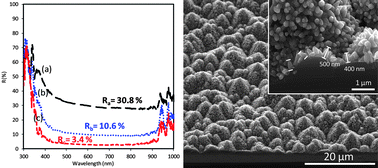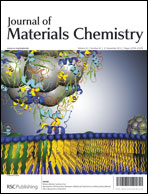Nanostructured ZnO as biomimetic anti-reflective coatings on textured silicon using a continuous solution process†
Abstract
A novel table-top, microreactor-assisted nanomaterial deposition (MAND™) process, which combines the merits of microreaction technology with solution-phase nanomaterial synthesis and film deposition, was used to grow a nanostructured ZnO anti-reflective coating on a textured silicon substrate from aqueous solution. The subwavelength, anti-reflective nanostructures mimicked the structure and performance of the surface of the eye from a night-flying moth. Solution-processed Ag nanoparticles were applied as a seed layer on the textured silicon surface leading to preferred heterogeneous nucleation and good area coverage. Preferential growth of the nanostructured ZnO was controlled by changing residence time, reaction temperature, and concentration of precursor solution without the use of a buffer reagent (e.g. HMTA). Well-aligned ZnO nanorod arrays were fabricated by MAND at a very high deposition rate (i.e. 125 nm min−1) compared to batch hydrothermal method. The surface reflection of the polished silicon was suppressed from an average of 30.8% between wavelengths of 400 and 900 nm to 10.6% after micro-scale pyramidal surface texturing to 3.4% after application of the ZnO nanostructure on the textured silicon. The results provide a potential economical path to broadband anti-reflection (AR) for silicon wafers and solar cell substrates.


 Please wait while we load your content...
Please wait while we load your content...